If you are not yet familiar with black-faced sheep breeds, you are in for a treat.
There are many different types of black-faced sheep, and they are some of the best breeds for a wide variety of purposes.
Black-faced sheep breeds are great animals to have for both wool and meat production.
Black-faced sheep provide approximately 40% of the world’s wool production.
The interesting aesthetic of a black face in sheep is a genetic trait passed onto offspring when breeding black-faced parents.
There is great diversity in their appearance, personalities, and living habits among the numerous sheep breeds with a black faces.
Table of Contents
ToggleSuffolk

Suffolk sheep are named for their origin in Bury St. Edmunds in England.
This breed dates back to the early 18th century and was produced by crossbreeding Norfolk Horn ewes (another British black-faced breed) with Southdown rams (the smallest British breed).
It is now one of the most common sheep breeds found in many countries worldwide, from Europe to the United States, to Australia.
The Suffolk sheep is white-wooled, with a short neck, black face, and black legs without wool.
This breed is polled, meaning it does not have horns as most rams do.
They are relatively large– a mature ram averages 250-350 lbs, and a mature ewe averages 180-250 lbs.
Their temperament is considered both intelligent and easy to herd.
Commercially, it is primarily used to produce excellent meat.
Below is some data on their fleece production:
- Average fleece weight from mature ewe: 5- 8 lbs
- Wool yield: 50-62%
- Medium wool type, springy, “down type” (resists felting and is good for socks, pillow stuffing, and quilt batting)
Norfolk Horn
The Norfolk Horn sheep is another British breed with white wool, a black face, and black legs without wool.
Its primary distinction from other black-faced sheep is its ability to live in areas with high rainfall and higher elevation areas.
It has a smaller body structure and hardy nature, allowing it to live in more diverse areas than the more commonly preferred lowlands.
They are also quite agile.
Their ability to jump over barriers such as fences is considered a negative trait, depending on their enclosure area.
The Norfolk Horn sheep are primarily used commercially for meat production.
There are few of these pure-breds, as they fell out of popularity once they were crossbred with other sheep for more desirable traits.
Black Welsh Mountain

As the name suggests, this breed originated from the mountains of Wales in the early 20th century.
Because of its native habitat, the breed is known for being resilient and self-reliant.
They are great foragers, even in conditions of limited pasture, and the ewes are great mothers.
It is the only completely black sheep breed in Britain.
Black Welsh Mountain sheep are a small to medium breed, producing about 3-4 pounds of wool per sheep.
Because of its black fleece, it is particularly useful either for making gray wool for black, undyed wool, or in combination with other colors.
It is a relatively rare, heritage breed with a global population of about 10,000.
Hampshire
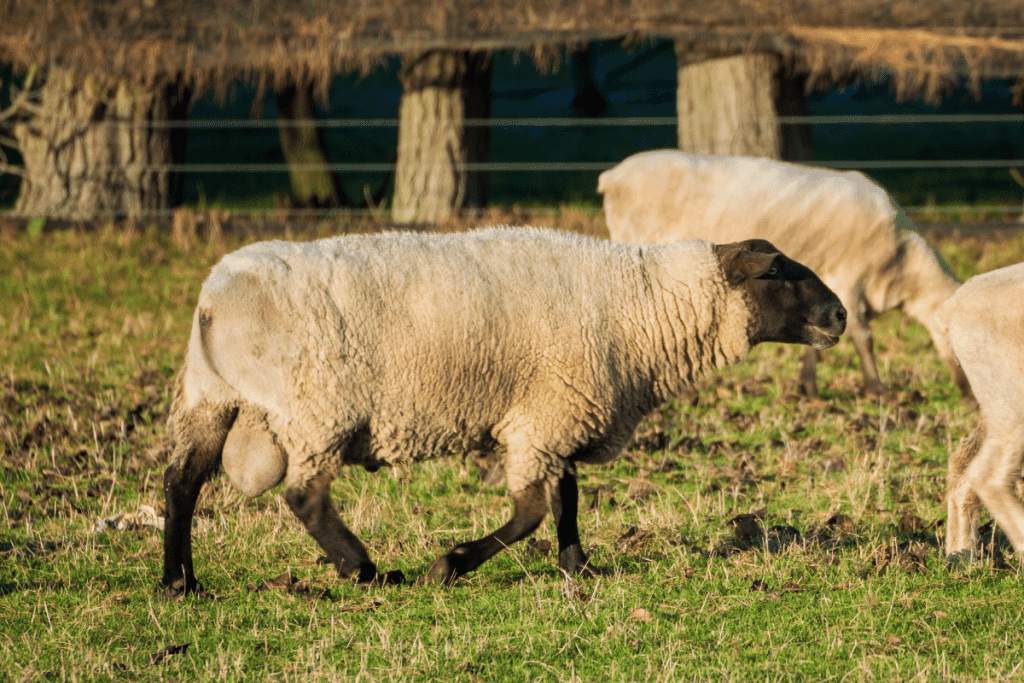
Hampshire sheep is yet another of the black-faced, domestic British sheep breeds.
This breed of sheep dates back to the early 19th century and has since become one of the most popular sheep breeds for meat in the United States.
One of its characteristics is early maturation, making it ideal for lamb production.
It also produces quality mutton.
Hampshire sheep have white fleece, black faces, and a distinctive, blocky body shape.
This breed produces medium fineness, durable wool but is less useful for commercial wool purposes due to the occasional black fibers mixed in with the white.
Here are a few statistics on their size and fleece production:
- Average ram weight = 300 lbs
- Average ewe weight = 200 lbs
- Wool yield = 6 -10 lbs
Zwartbles
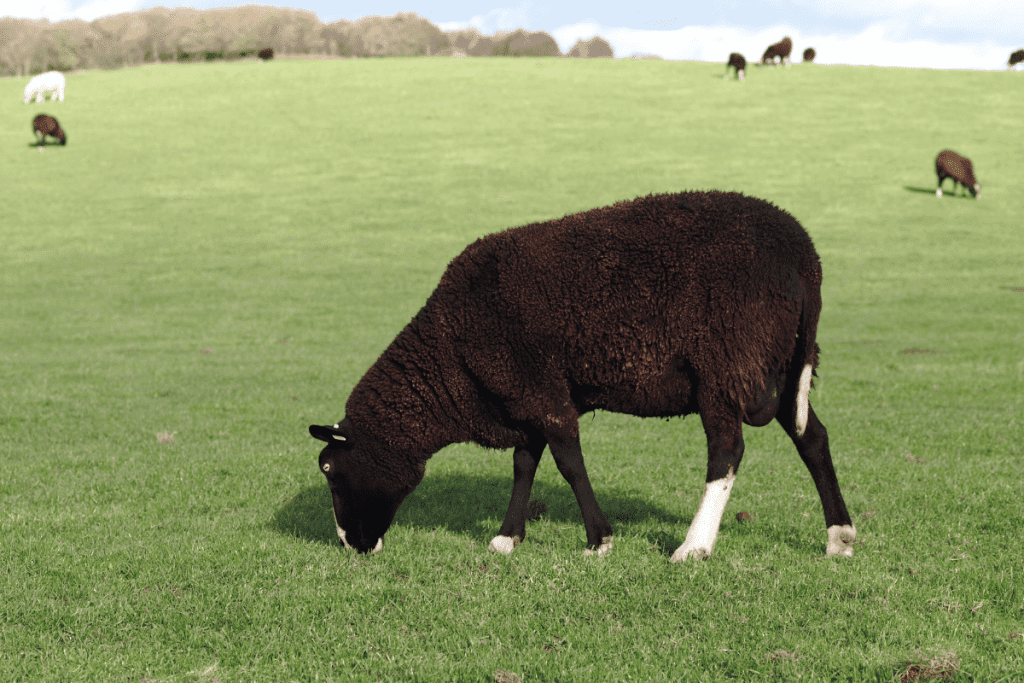
Zwartbles sheep were originally produced in the Netherlands and were primarily used to produce milk, mutton, and lamb.
They have a distinctive appearance– a blackish, brown wool, a white stripe down its mostly black face, white socks (2-4), and a white-tipped tail.
Zwartbles have an excellent temperament and tend to be quite social, friendly, and docile.
They produce medium wool with sun-bleached tips.
These need to be trimmed to produce a black to brown fleece quality.
The fleece has a good crimp and length, making it particularly useful for spinning and felting.
Zwartbles are hardy sheep and make great mothers.
They are used for crossbreeding purposes and for producing lean meat throughout the U.K, although they are currently a relatively rare breed.
Clun Forest
Clun Forest sheep, sometimes known simply as “Clun,” originate from Shropshire, England, in the forests it is named for.
These domestic sheep can currently be found in herds throughout the world.
As a breed native to the highlands, it is very hardy, self-reliant, long-lived, and great at foraging. Its adaptable nature allows it to live in diverse geographic areas.
It is a medium-sized breed of sheep with an attractive appearance.
Clun Forest sheep have upright ears, black faces and legs, and white wool covering the top of their head.
Clun Forest sheep have a lively temperament and are pretty easy to handle and shepherd compared to other sheep breeds.
They are used to produce wool, milk, and meat, and their wool is particularly valuable due to the lack of any black fibers in its white fleece.
The short, elastic, excellent wool of the Clun Forest is excellent for hand spinning, hosiery, and knitting yarns.
Clun Forest sheep produce milk with one of the highest buttermilk contents among all breeds.
The ewes are great mothers and tend to produce twins.
The lambs mature quickly due to this nutritious milk.
They are suitable for grazing on grass and produce lean, mild meat.
Check out more all black sheep breeds.
Scottish Blackface
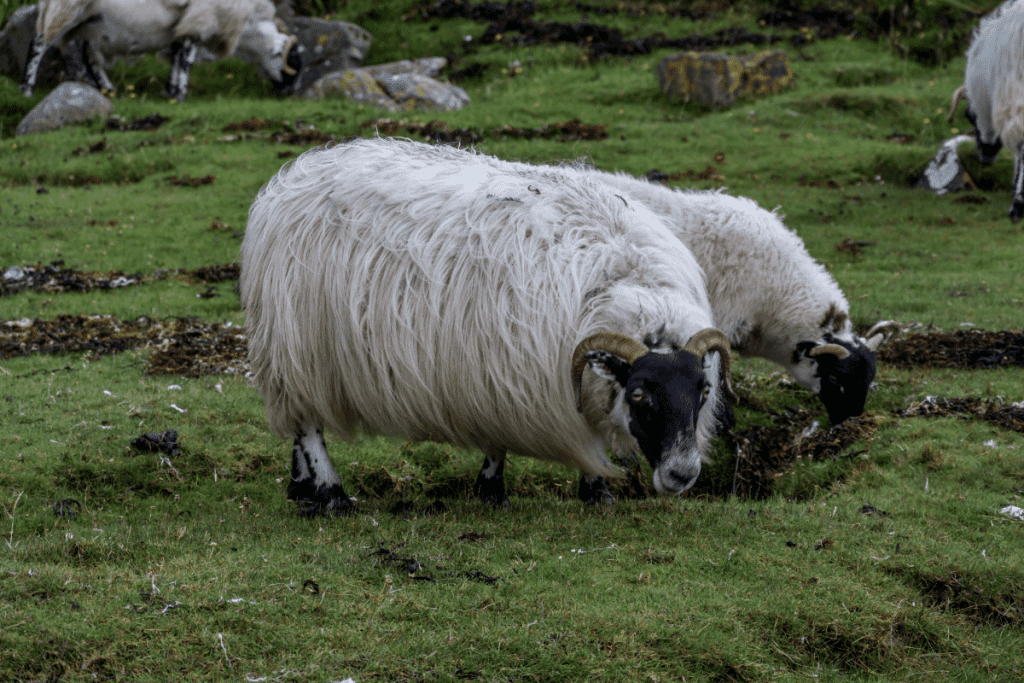
Although the exact origins of the Scottish Blackface are unknown, there is documentation of the development of this hybrid sheep by monks as early as the 12th century near Scotland.
Monks traditionally used the wool from these sheep to produce their clothes and export them throughout Europe.
The ewes are great mothers, produce an abundance of milk, and are very protective of their young.
Related: Best sheep breeds for milk production
Scottish Blackface sheep are also quite hardy and can yield quality meat and wool, even in conditions of limited grass pasture.
Although they are now found in the United States, Italy, and Argentina, they are not a very commonly found breed in these areas.
However, they are one of the most commercially significant breeds in the U.K today, accounting for almost 40% of all wool production in Scotland and over 8% of all the wool in the U.K.
Scottish Blackface is particularly valuable in these regions because they are well adapted to a hilly environment.
They are a great producer of carpet wool due to the durability and natural springiness of the fleece.
This fleece holds up well under the pressure of walking and furniture.
Their meat is very lean, with a distinctive flavor.
Valais Blacknose
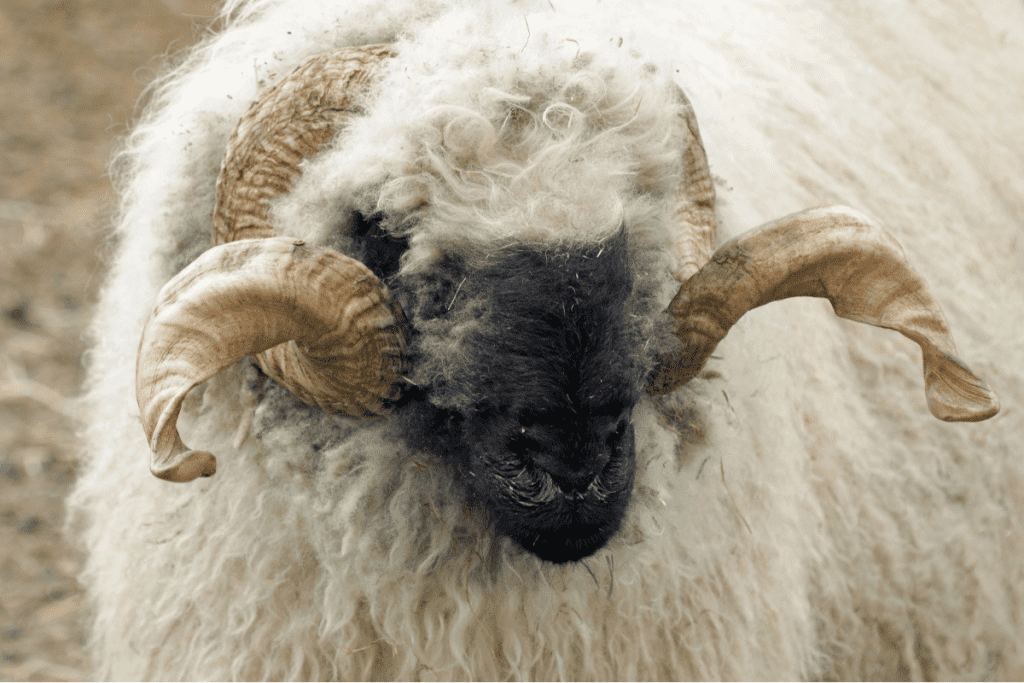
The Valais Blacknose sheep are native to the Valais region of Switzerland.
Because of this origin in a harsh mountain habitat, they are among the hardiest sheep breeds able to navigate rocky slopes and steep hills.
They have a stunning appearance, most easily identified by their spiral-shaped horns with black knees, ears, nose, hocks, and feet with white fleece.
Both the ewes and rams have striking horns.
With their unique appearance and thick, curly fleece, many consider them one of the cutest sheep breeds.
They also happen to have a great temperament and are very friendly.
The Valais Blacknose sheep were imported to Britain around 2013, but direct importation is still not allowed into the United States.
The Valais Blacknose is still a relatively rare breed.
Its wool is coarse, and this breed is raised for both meat and wool.
Shropshire

Shropshire sheep originate from North Staffordshire in England during the 19th century.
Shropshires tend to have an active and alert temperament.
They are pretty gentle, making them a good choice for both commercial flock owners and hobby farmers with children around.
They are a medium-sized, polled variety with black ears, face, and legs with white wool.
They are used for meat, milk, and wool production.
Shropshire sheep do well on pasture and are particularly suitable in cases where you do not want sheep to damage trees, such as orchard pastures.
Another positive quality of this breed is their great mothering.
Shropshires produce an abundance of milk and vigorous and resilient lambs.
They produce a very fine and dense fleece, mostly free from black and gray fibers.
The average fleece weight is 4.5 – 6.5 lbs.
This down-type wool is excellent for hosiery and knitting yarns.
There is also a fairly large market for Shropshire wool in Japan, where it is used as filling in sofa beds.
Related: Best sheep breeds for wool
Karakul

Karakul sheep are a seemingly ancient breed of sheep dating back to 1400 BC in the deserts of Central Asia.
Because of their adaptation to areas with very little vegetation and water, they are an extremely hardy breed.
Karakul can survive on poor pasture and are even resistant to footrot and parasites.
These animals were essential to early sheep raisers as they produced beautiful pelts, milk, tallow, meat, and wool, which were used to make fabric and carpets.
Their wool has a wide range of colors, including grays, browns, white, silvery-blue, and gold.
The fiber is strong and easy to spin.
Karakul sheep are very protective mothers, and the lambs have a high survival rate.
The Karakul was introduced into the United States in the early 1900s, but they were often crossbred due to the scarcity of the breed and high demand for their pelts.
This led to a diminishing population of pure-breed Karakuls.
Despite their many positive traits, they are not the ideal breed for herding, as they tend to scatter and do not react well to herding dogs.
Today, they are a rare and endangered breed of sheep.
Dorper
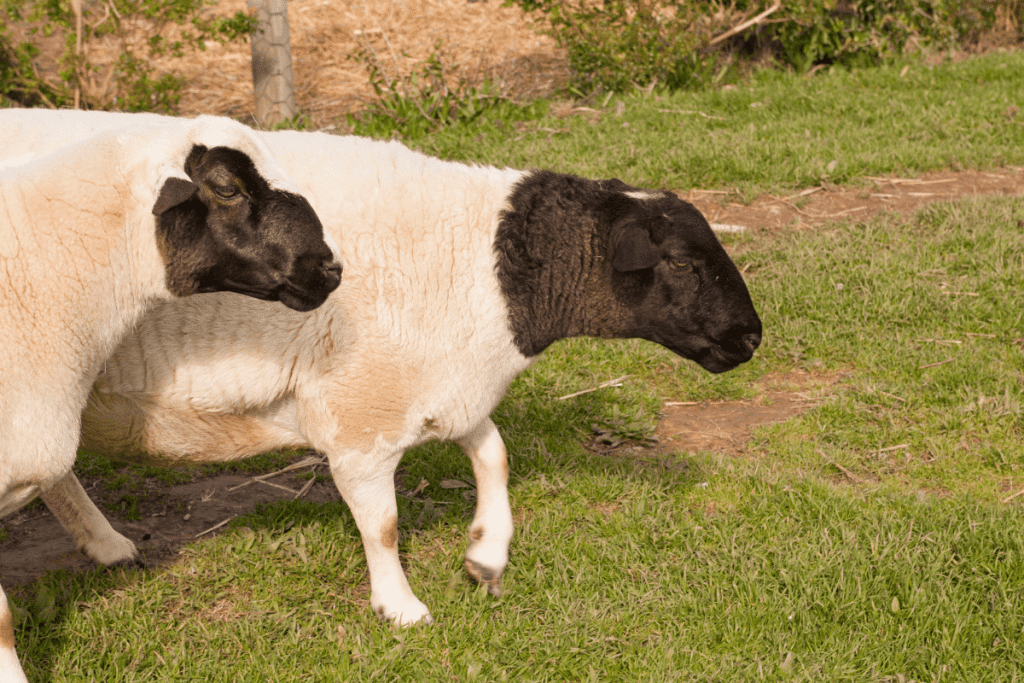
Dorper sheep were developed in South Africa during the 1930s.
They can either be all-white or have a white body and a striking, all-black head from the neck forward.
Dorper sheep are the second most common breed of domestic sheep in South Africa.
Dorpers are also found in other countries worldwide in harsh conditions such as arid climates, tropical areas with heavy rainfall, and frigid weather.
This breed is primarily raised for meat and sheepskin.
The skin is thick and highly sought after, accounting for 20% of the carcass’s total value.
Dorper sheep are very fertile and can give birth three times in 2 years.
The lambs also grow quickly, making it an efficient mutton breed.
Romanov

Romanov sheep are native to the Volga Valley of Russia, making these black-faced sheep genetically distinctive from European and North American black-faced breeds.
Their most extraordinary trait is their fertility and ability to produce large litters.
Four to six lambs in each birth are normal for Romanovs, and the North American record for a single litter is 9 lambs!
The Romanov sheep reach sexual maturity at the unusually young age of 3 months old, and they will breed at any time of the year.
The newborn lambs have a reasonable survival rate, making the Romanovs a true powerhouse in reproduction.
These traits make them very popular for crossbreeding and a good breed for meat production.
Pure-breed Romanovs are usually all-black when they are born, and over time they start to gray and keep a primarily black face.
Romanovs are technically classified as hair sheep, meaning they do not produce wool.
However, their fleece is often shorn regularly for maintenance.
They are a hardy breed, well adapted to the cold conditions of Russia, and are great foragers.
How useful was this post?
Click on a star to rate it!
We are sorry that this post was not useful for you!
Let us improve this post!
Tell us how we can improve this post?
